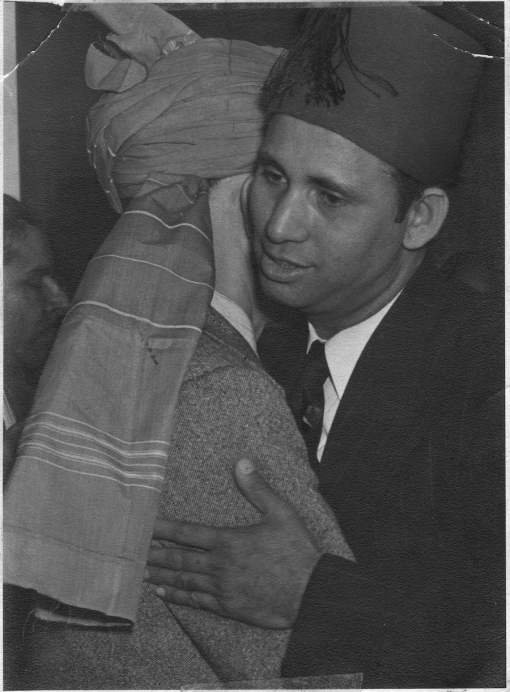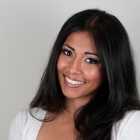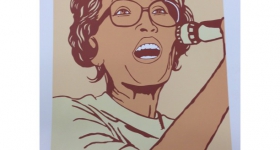“I talk for those of our men who, in factory and field, in
all sections of American industry, work side by side with their fellow American
workers to strengthen the industrial framework of this country.” -Ibrahim Chowdry, in a letter given for testimony during
the US Congressional Committee on Immigration and Naturalization hearings in
1945.
Ibrahim Chowdry is the reason I am an American. He was
my grandmother’s first cousin, and he sponsored my family to come to the United
States from Bangladesh. He was also the first documented Bangladeshi man to
settle in New York City, arriving in the 1920s. This was more than half a century before South Asians immigrated to the US en masse in the 1980s.
The recent wave of immigration monopolizes the narrative of
South Asians in this country. Even though Punjabi farmers arrived on West Coast
during the late 19th and early 20th centuries, and indentured
servants and maritime workers came ashore to America in small numbers as early
as the 1600s, South Asian immigration in the US is still viewed as a recent
phenomenon.
Yet, the letter to Congress mentioned at the beginning not only
highlights the lives of those within an earlier South Asian American generation, but also reveals the activities of a political pioneer.
Chowdry came to the US at a time when immigration laws closed
the US to Asians and South Asians alike. Laws such as the notorious Chinese Exclusion Act of 1882, the Immigration Acts of 1917
and 1924, and the 1923 Supreme Court decision, The United States v. Bhagat Singh Thind, forced South Asian
migrants to stay largely hidden from historical records. Their stories were
only passed down through family tradition and storytelling.
The men who came from present day Bangladesh (then the East
Bengal region of the British Raj) settled in areas such as New York City,
Detroit, New Orleans and Ohio. They came from labor and working classes, and many
were maritime laborers and peddlers.
Their stories are now told by Vivek Bald, an associate
professor at the Massachusetts Institute of Technology (MIT) and the author of a new book, Bengali Harlem and the Lost Histories of South Asian America. Released in January, the book details the untold
stories of earlier South Asian migrant workers.
Bald said he pursued this topic in part because “these
histories were so counter to the history that I’ve been led to understand. We’re
used to South Asian history in which there was this gap between 1917 and 1965, where
supposedly nothing was going on.”
In reality, many things happened during that “gap.” For one,
a group of Bangladeshi men settled down and married Latino and African American
women, creating a richly diverse community. Many of them pooled their money to help
open restaurants and small businesses. They started organizations to empower
their communities and offered social support for new immigrants who moved in.

Ibrahim Chowdry, a Bengali community organizer in New York.
Ibrahim Chowdry was at the forefront of these efforts. He
escaped a British crack down over his political activities in East Bengal and settled
in New York City in the 1920s, where he initiated numerous community
organizations to help his fellow East Bengalis and built connections with other
ethnic enclaves in the city. His first community organization, the Indian
Seamen’s Club, provided a place of dining, rest, and congregation for South
Asian maritime workers on shore leave in the city.
His son, Noor, said in the book that
Ibrahim Chowdry “helped ex-seamen with immigration problems, led religious
functions and interfaced on his community’s behalf with British, Indian and
Pakistani consular officials. Chowdry even went from one New York-area
hospital to the next, meeting with staff and asking them to call him whenever
anyone was admitted with the surnames Meah, Ullah, Uddin, or Ali.”
Laila Chowdry, Ibrahim’s daughter, described her father in the book as a key community leader.
“We lived in an apartment with a lot of rooms and he had a couple of his
countrymen living there always," she said. "Usually they (Bengali countrymen) would call
him on the phone and he would run off. If someone was sick or if someone died,
he would make their funeral arrangements.”
Aladdin Ullah, a writer and comedian in New York City whose
father, Habib, was a close friend of Chowdry’s, said Chowdry knew Malcolm X personally.
Malcolm X’s Nation of Islam followers shared the
same neighborhoods as the Bangladeshi immigrants and the two groups would debate each other over religious practices.
“Chowdry was such a devout Muslim that he
interacted and spoke to these men about Islam,” Ullah said. “There was a
picture, I remember as a child, of my uncle Ibrahim and Malcolm X together.”
Chowdry’s dedication to the Muslim community
expanded beyond Harlem. He was involved in coalition-building efforts with African
American Muslims and Middle-Eastern Muslims, and reached out to Christians and Jews to form interfaith groups. He established the first mosque in New York City, the Al Madina Mosque, which still stands
today.
The stories of Bangladeshis in Harlem should also
be noted for their unique place in history. These were men who left a country
under British colonial rule, only to come to a country going through a period
of rapid change, as well as turbulence on issues of race and immigration.
They arrived in America where Jim Crow laws were in full effect and interracial marriages were banned outright.
Ullah, the writer/comedian, recalled a story of his father visiting a cousin
who migrated to Atlanta in the 1950s. They went to a restaurant where they
were promptly rejected service, with the waitress commenting, “We don’t serve
niggers and spics.”
This climate pushed these early immigrants to build coalitions and rely on multicultural communities. It prompted these Bangladeshi men to see Puerto Ricans and Blacks as their neighbors and political allies.
“They couldn’t afford to be racist, they had to
depend on humanity instead of discriminating against it,” Ullah said.
Today, efforts to cross the racial divide are rare. Community organizing often splits along race and ethnic lines.
The newer wave of South Asian immigrants, many
of whom are educated engineers and Ivy League graduates, seldom share working class struggles, or promote intercultural unity.
Bald and Ullah aim to continue
expanding their efforts to document these stories for the public to consider. Ullah wrote and is currently performing in Dishwasher Dreams, a one-man show based on his father's journey. They are also collaborating on a documentary about the history of Bengali Harlem,
and Bald is using his website to
host a digital oral history project, with hopes that the children of mixed
marriages from that era will come forth to share their stories.
To me, sharing these stories means giving a sense
of heritage to South Asian Americans, and especially to the often-marginalized Bangladeshi
community. It is very powerful to know that our US presence is not just 20 to
30 years old, and that our forefathers are part of the complex tapestry that is
American history.
Perhaps this example parallels other AAPI groups,
and demonstrates that there could be more to the story of immigration than what
is presented in mainstream dialogue. We are a deeper part of this country than
we realize. My lineage in the US may not trace back to the Mayflower, nor am I
a member of the Daughters of the American Revolution. But I can now say I have
my roots in Bengali Harlem, and I could not be prouder.










Comments
What you point out is true, but the clarification had already been made in the article, in the line "The men who came from present day Bangladesh (then the East
Bengal region of the British Raj"." These men were mostly Muslim men from the region of East Bengal, from villages such as Syhlet and Noakhali, which are in current day Bangladesh. ibrahim Chowdry himself lived to see Bangladesh become a nation in 1971 and considered himself Bangladeshi, as did his fellow community members who lived to see the establishment of the state of Bangladesh. Due to these facts, and the self identification of the men in question, they are referenced as "Bangladeshi".